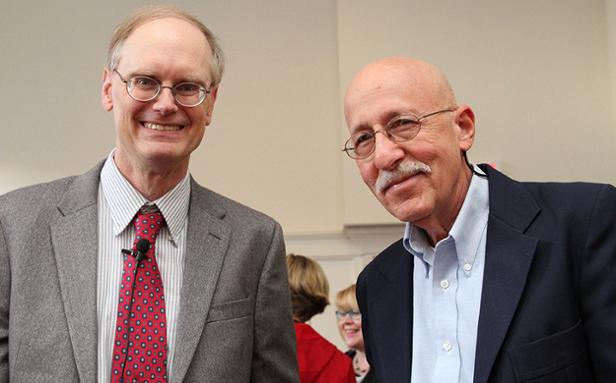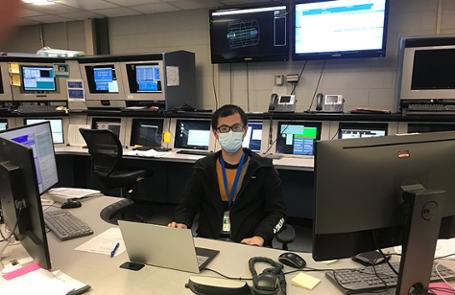
DISCOVERY:
Physicists closing in on the mass of neutrinos
Story by Cheryl Pierce
Published March 04, 2022
It is estimated that over 100 trillion neutrinos pass through your body every second. The neutrino is a neutral subatomic particle that is the lightest known particle in our universe. They are everywhere. Born of radioactive decay and other subatomic processes, an uncountable number of neutrinos are flying through us, through our planet, and through our universe. Most neutrinos in our solar system come from the nuclear processes in the Sun which produce the Sun's energy. Even though they are one of the most abundant subatomic particles in the universe, they interact so weakly that there is a lot that is not known about them, including their masses.
When the neutrino was first detected in 1956 by Clyde Cowan and Fred Reines, the scientific world was comfortable with the notion that most likely they didn't have any mass at all. By the 1970s, a total of three different kinds, or “flavors,” of neutrinos had been discovered (the electron-neutrino, muon-neutrino, and tau-neutrino), but all of them were believed to be massless.
Since neutrinos produced in the core of the Sun by nuclear fusion reactions can easily pass through the Sun and into space, it was natural to try to detect them to learn more about how the Sun produced its energy. However, after the Homestake mine experiment conducted by Ray Davies began running to detect these solar neutrinos in the late 1960s, a discrepancy emerged between the number of electron-neutrinos observed and the number predicted by nuclear physics models. This “solar neutrino problem” puzzled physicists for many years- did the discrepancy arise from a problem with the experiment or the nuclear physics calculations?
It was against this backdrop that in 1996 Dr. Ephraim Fischbach, Professor of Physics and Astronomy at Purdue University, published a 78-page paper entitled "Long Range Forces and Neutrino Mass” in the journal Annals of Physics [ref.1]. In this work, Fischbach argued that neutron stars could not exist if neutrinos were massless. Neutron stars are the remnants of massive stars that have exploded when they have used up their nuclear fuel. With masses slightly larger than our Sun, neutron stars are compressed by gravity down to a diameter of about 12 miles and are essentially made solely of neutrons. Professor Fischbach showed that if neutrinos were massless, the energy associated with neutrino interactions between the neutrons in a neutron star would destabilize it. Only if the lightest neutrino masses were greater than about 0.4 eV, over 10,000 times smaller than the mass of the electron, could neutron stars form. It turned out that the mass of the neutrino also held the key to resolving the solar neutrino problem.
After years of refining neutrino experiments and solar nuclear physics calculations, it slowly emerged that the solution to the paucity of electron-neutrinos arriving at the Earth from the Sun was truly astonishing: neutrino oscillations. The electron-neutrinos emitted by the Sun were transforming into the other two flavors as they traveled to the earth. Since the Homestake mine only detected electron-neutrinos and not the other two flavors, it missed observing the neutrinos that had changed their identities by the time they reach Earth. Later experiments which could detect all three flavors confirmed this results, and Takaaki Kajita and Arthur MacDonald were award the 2015 Physics Nobel Prize for their work on these experiments.
How is the phenomenon of neutrino oscillations related to neutrino mass? If neutrinos were truly massless, they would travel at the speed of light. According to Einstein’s theory of relativity, a clock traveling at the speed of light would be frozen in time relative to a stationary observer—it would not tick. Anything massless which travels at the speed of light cannot change. Neutrinos are changing, so they are not traveling at the speed of light. Hence, neutrinos cannot be massless!
Actually, the situation is a little more complicated. The shifting nature of the neutrino flavors means, by the weirdness of quantum mechanics, that the flavor neutrino states do not have definite masses. And the states with definite masses (the mass states) do not have definite flavor. For neutrino oscillations to occur, quantum mechanics tells us that at most only one of the mass states can be massless. This set off an experimental effort to determine the masses of the neutrino mass states.
Fast forward to 2022, and the scientific community is newly abuzz with new neutrino mass chatter. On Valentine's Day this year, February 14th, the Karlsruhe Tritium Neutrino (KATRIN) collaboration published a love letter to the world's physics community in which they presented their latest experimental results: the neutrino mass could be no greater than 0.8 electron volts. This result, when combined with lower limit derived by Fischbach, suggests that the neutrino mass may lie in the narrow range 0.4-0.8 electron volts. In fact, Fischbach has been in contact with the leaders of the KATRIN experiment. He conveys that they feel confident that within the next three years, they will be able to determine the mass of a neutrino even if it as small as 0.2 eV. Getting down to 0.2 eV will be a challenging task, given that a neutrino of this mass would have a mass-energy corresponding to a single infrared photon.
However, once this mass is determined, whatever its value, that will serve as critical input to many calculations in the world of astroparticle physics dealing with the past and future of our Sun, and other related astrophysical questions.
About the Department of Physics and Astronomy at Purdue University
Purdue Department of Physics and Astronomy has a rich and long history dating back to 1904. Our faculty and students are exploring nature at all length scales, from the subatomic to the macroscopic and everything in between. With an excellent and diverse community of faculty, postdocs, and students who are pushing new scientific frontiers, we offer a dynamic learning environment, an inclusive research community, and an engaging network of scholars.
Physics and Astronomy is one of the seven departments within the Purdue University College of Science. World class research is performed in astrophysics, atomic and molecular optics, accelerator mass spectrometry, biophysics, condensed matter physics, quantum information science, particle and nuclear physics. Our state-of-the-art facilities are in the Physics building, but our researchers also engage in interdisciplinary work at Purdue’s Discovery Park, particularly the Birck Nanotechnology Center and the Bindley Bioscience Center. Furthermore, we participate in global research including at the Large Hadron Collider at CERN, Argonne National Laboratory, Brookhaven National Laboratory, Fermilab, the Stanford Linear Accelerator, the James Webb telescope, and several observatories around the world.
Contributors: Dr. Ephraim Fischbach, Professor of Physics and Astronomy at Purdue University
Dr. Dennis Krause, Adjunct Faculty and alumni of Physics and Astronomy at Purdue University and Professor of Physics at Wabash College
Written by: Cheryl Pierce, Communications Specialist, Purdue Physics and Astronomy
Ref. 1: “Long Range Forces and Neutrino Mass” by Dr. Ephraim Fischbach


